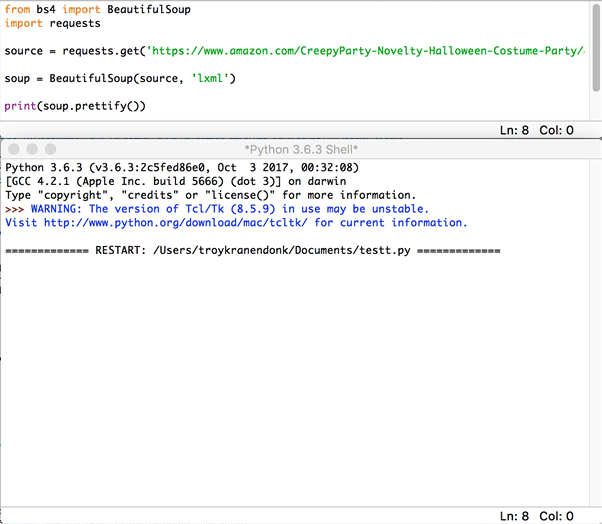How To Download Requests Package In Python Mac
Browse other questions tagged python python-requests or ask your own question. The Overflow Blog Podcast 268: How developers can become great writers. The official home of the Python Programming Language. Downloads Mac OS X; Python Releases for Mac OS X. Latest Python 3 Release - Python 3.9.0; Latest Python 2 Release - Python 2.7.18; Stable Releases. Python 3.9.0 - Oct. Download macOS 64-bit installer. Pgrequests 0.1.0 Nov 1, 2017 PostgreSQL-specific query builder library. Requests-cloudkit 1.0.1 Apr 26, 2018 Apple CloudKit server-to-server support for the requests Python library. Requests-middleware 0.1.2 Nov 7, 2015 Composable HTTP middleware for requests. Requests-kerberos 0.12.0 Dec 20, 2017 A Kerberos authentication handler for python. Import the requests Package. The first step is to import the Python requests package. This package will allow us to make HTTP get requests and store the response as an object. Import requests. Downloading and Saving an Image. Now we have the requests package imported, we can make an HTTP GET request to the URL of an image before saving the. Double check the install has happened by browsing to the site-packages folder of Python (C:Python34Libsite-packagesrequests.egg) Open IDLE GUI Utility (installs with Python and should be in the Python Program Files directory) Import the Python package with IDLE by typing: import requests (hopefully no errors arise here and a new command.
Mac OS X comes with Python 2.7 out of the box.
You do not need to install or configure anything else to use Python 2. Theseinstructions document the installation of Python 3.
The version of Python that ships with OS X is great for learning, but it’s notgood for development. The version shipped with OS X may be out of date from theofficial current Python release,which is considered the stable production version.
Doing it Right¶
Let’s install a real version of Python.
Before installing Python, you’ll need to install GCC. GCC can be obtainedby downloading Xcode, the smallerCommand Line Tools (must have anApple account) or the even smaller OSX-GCC-Installerpackage.
Note
If you already have Xcode installed, do not install OSX-GCC-Installer.In combination, the software can cause issues that are difficult todiagnose.
Note
If you perform a fresh install of Xcode, you will also need to add thecommandline tools by running xcode-select--install on the terminal.

While OS X comes with a large number of Unix utilities, those familiar withLinux systems will notice one key component missing: a package manager.Homebrew fills this void.

To install Homebrew, open Terminal oryour favorite OS X terminal emulator and run
The script will explain what changes it will make and prompt you before theinstallation begins.Once you’ve installed Homebrew, insert the Homebrew directory at the topof your PATH environment variable. You can do this by adding the followingline at the bottom of your ~/.profile file
If you have OS X 10.12 (Sierra) or older use this line instead
Now, we can install Python 3:
This will take a minute or two.
Pip¶
Homebrew installs pip pointing to the Homebrew’d Python 3 for you.
Working with Python 3¶
At this point, you have the system Python 2.7 available, potentially theHomebrew version of Python 2 installed, and the Homebrewversion of Python 3 as well.
will launch the Homebrew-installed Python 3 interpreter.
How To Download Requests Package In Python Machine Learning
will launch the Homebrew-installed Python 2 interpreter (if any).
will launch the Homebrew-installed Python 3 interpreter.
If the Homebrew version of Python 2 is installed then pip2 will point to Python 2.If the Homebrew version of Python 3 is installed then pip will point to Python 3.

The rest of the guide will assume that python references Python 3.
Pipenv & Virtual Environments¶
The next step is to install Pipenv, so you can install dependencies and manage virtual environments.
A Virtual Environment is a tool to keep the dependencies required by different projectsin separate places, by creating virtual Python environments for them. It solves the“Project X depends on version 1.x but, Project Y needs 4.x” dilemma, and keepsyour global site-packages directory clean and manageable.
For example, you can work on a project which requires Django 1.10 while alsomaintaining a project which requires Django 1.8.
So, onward! To the Pipenv & Virtual Environments docs!
Python Requests Package
This page is a remixed version of another guide,which is available under the same license.